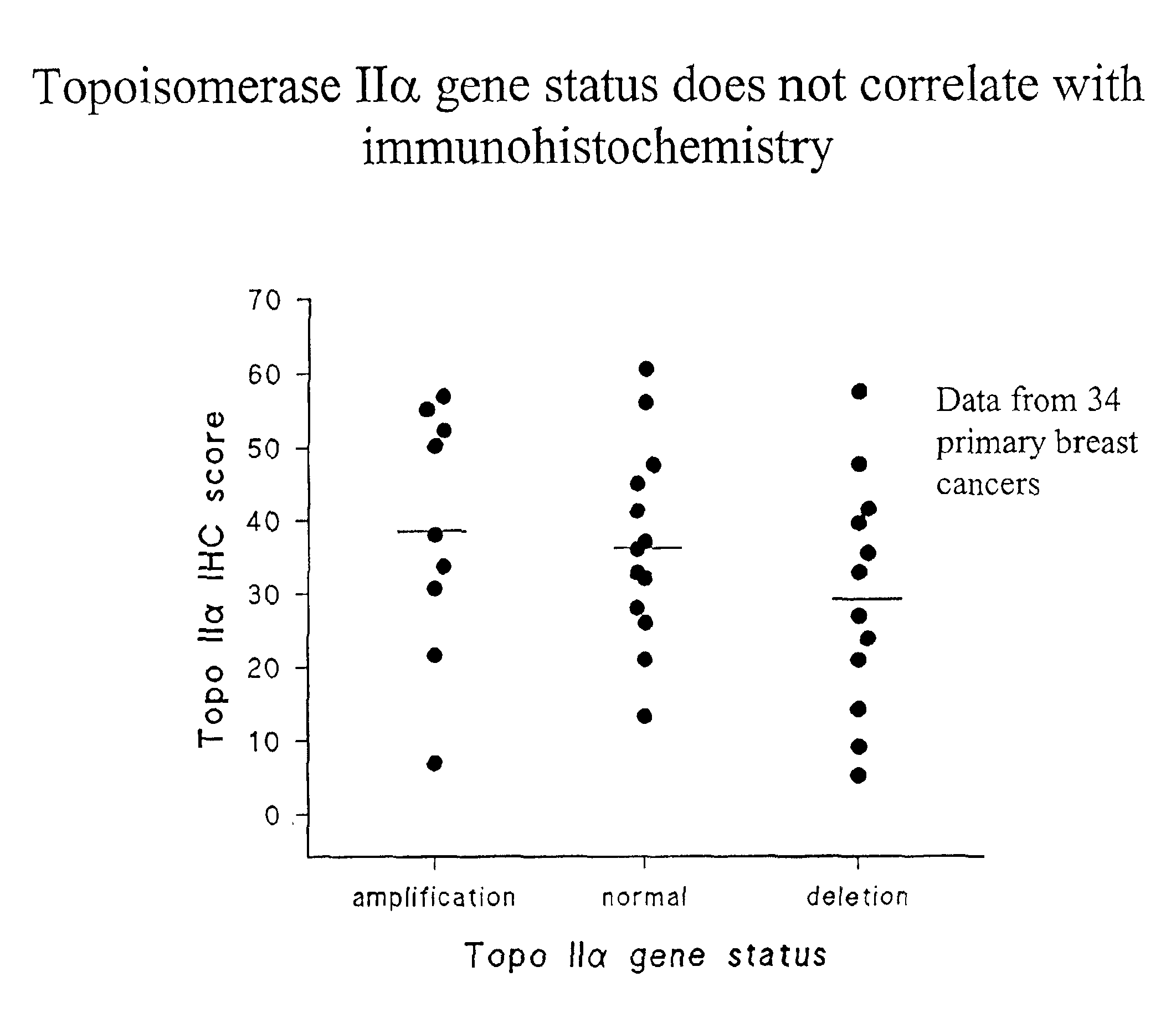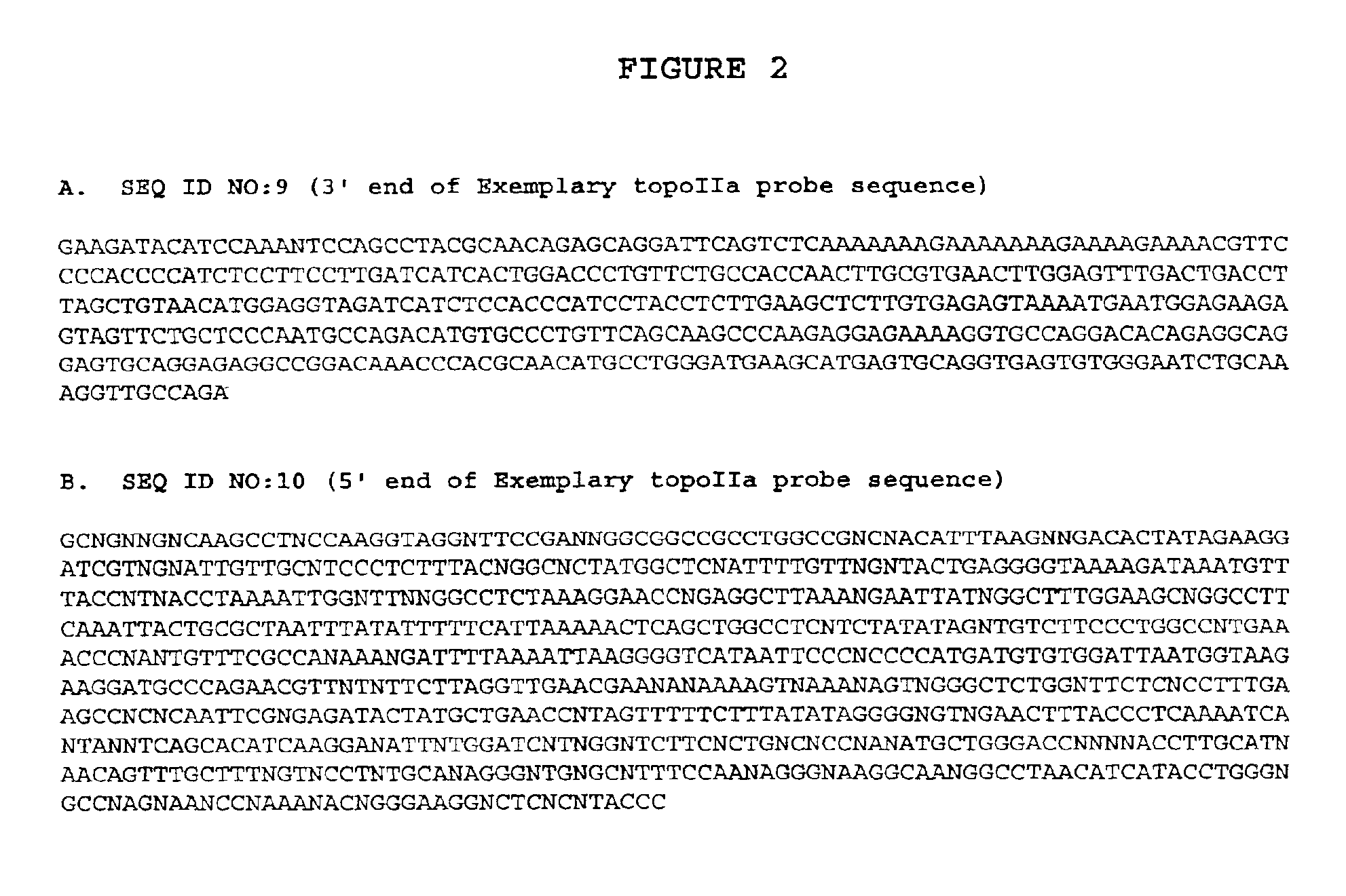Identifying subjects suitable for topoisomerase II inhibitor treatment
a topoisomerase inhibitor and subject technology, applied in the field of cancer diagnosis and treatment, can solve the problems of affecting the clinical outcome of breast cancer patients, and affecting the clinical outcome of patients with overtly metastatic disease. 5 to 10% of breast cancer patients with overtly metastatic disease achieve complete clinical remission
- Summary
- Abstract
- Description
- Claims
- Application Information
AI Technical Summary
Benefits of technology
Problems solved by technology
Method used
Image
Examples
example 1
TopoIIα and HER-2 / neu Gene Copy Numbers In Breast Cancer Cell Lines
[0083]This examples describes the characterization of topoIIα and HER-2 / neu gene copy numbers in nine breast cancer cell lines by dual color fluorescent in situ hybridization (FISH) assays. The nine breast cancer cell lines assayed were: BT-474, DU4475, MCF-7, MDA-157, MDA-361, SK-BR-3, ZR-75-1, UACC-812, and UACC-893. A normal human lymphocyte cell line was also used. All cell lines were obtained from the American Type Culture Collection (ATCC, Rockville, Md.). The breast cancer cell lines were grown using recommended culture conditions and harvested at confluency to obtain interphase nuclei from cells that were predominantly in the G1-phase of the cell cycle. The cells were subsequently fixed in methanol:acetic acid (3:1) and placed on microscope slides (see, Tanner et al., Cancer Res., 54:4257 [1994]).
[0084]Dual-color FISH experiments were done as known in the art (See e.g., Tanner et al., supra), employing probes...
example 2
TopoIIα and HER-2 / neu Gene Copy Numbers in Primary Breast Cancer Samples
[0089]This example describes the characterization of the copy number for HER-2 / neu and topoIIα in primary breast cancer samples. One hundred and thirty-six (136) freshly frozen primary breast tumors were derived from the tumor bank at the University of Lund (Lund, Sweeden). HER-2 / neu status was previously determined by Southern blotting in 74 of the primary tumor samples (50 samples with reported amplification and 24 samples with reported normal levels of HER-2 / neu). Dual color FISH assays were performed on these samples as described above (See, Example 1), in order to detect the HER-2 / neu status of each sample.
[0090]FISH detection revealed that 47 of the 50 tumor samples with HER-2 / neu amplification as determined by Southern blot also showed amplification by FISH. Also, four low-level HER-2 / neu amplifications were identified by FISH in the 24 samples reported to have normal levels of HER-2 / neu by Southern Blott...
example 3
Characterization of TopoIIα-HER-2 / neu Amplification by Fiber FISH
[0092]This example describes the characterization of topoIIα-HER-2 / neu amplification by fiber FISH in the UACC-812 cell line. Mechanically extended DNA fibers were prepared from UACC-812 cells by first embedding the cells in 0.9% agarose (See, Heiskanen et al., Genomics, 30:31 [1995]). A small piece of the agarose block was placed on a poly-L-lysine-coated (Sigma) microscope slide and heated on a 95° C. hot plate for 20 seconds. The melted agarose was spread along the microscope slide mechanically with another microscope slide and air dried for 30 minutes. This resulted in the extension of the DNA fibers. The fiber-FISH (for topoIIα and HER-2 / neu) was carried out according to the same procedure as described in Example 1 above for FISH. However, proteinase K digestion of the target DNA was omitted and hybridization efficiency was increased by applying denatured probes on the denatured target DNA and re-denaturing them t...
PUM
| Property | Measurement | Unit |
|---|---|---|
| Temperature | aaaaa | aaaaa |
| Temperature | aaaaa | aaaaa |
| Fraction | aaaaa | aaaaa |
Abstract
Description
Claims
Application Information
 Login to View More
Login to View More - R&D
- Intellectual Property
- Life Sciences
- Materials
- Tech Scout
- Unparalleled Data Quality
- Higher Quality Content
- 60% Fewer Hallucinations
Browse by: Latest US Patents, China's latest patents, Technical Efficacy Thesaurus, Application Domain, Technology Topic, Popular Technical Reports.
© 2025 PatSnap. All rights reserved.Legal|Privacy policy|Modern Slavery Act Transparency Statement|Sitemap|About US| Contact US: help@patsnap.com



